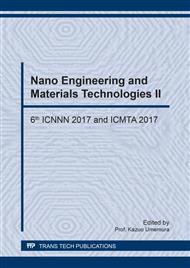p.3
p.10
p.14
p.19
p.24
p.33
p.38
p.45
Comparison of Morphology and Mechanical Properties of Polyoxymethylene/Cellulose and Poly(Lactic Acid)/Cellulose Composites
Abstract:
The objective of this study is to fabricate the polyoxymethylene (POM)/microcrystalline cellulose (MCC) and poly(lactic acid) (PLA)/MCC composites, and to compare the effect of MCC on the morphology and mechanical properties of POM and PLA. The polymer composites were prepared by melt mixing in an internal mixer and molded by compression molding. The MCC concentrations were 1, 3, 5, 7, 10, 15 and 10% by weight. From scanning electron microscopy study observes the fracture surface of POM and PLA composites is much rough and the roughness increases with increasing MCC content. This observation indicates MCC induces the ductile fracture characteristic of POM and PLA. The addition of MCC can improve the impact strength of PLA composite and improve Young’s modulus of both POM and PLA composites. While the tensile strength and strain at break decrease after adding MCC. In summary, MCC can enhance the morphology and mechanical properties of PLA composites is better than POM composites.
Info:
Periodical:
Pages:
19-23
Citation:
Online since:
March 2018
Keywords:
Price:
Сopyright:
© 2018 Trans Tech Publications Ltd. All Rights Reserved
Share:
Citation:


